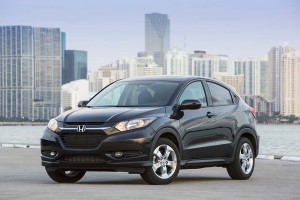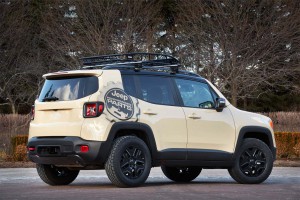When it comes to cars, Americans have traditionally thought that bigger is better. Yet, Honda is betting big on the smallest entry in its expanding SUV line-up. The new 2016 HR-V shares the same underlying platform as the Japanese maker’s subcompact Fit hatchback, and it’s expected to serve as “a gateway to our line-up,” says Jeff Conrad, the general manager of the Honda brand.
But Honda is by no means alone. What was once a modest niche is rapidly becoming one of the market’s hottest segments. It’s hard to find a single major manufacturer that doesn’t have a small utility vehicle in its showrooms, or at least one on the way.
Sales are expected to nearly triple this year, to around 236,000, forecasts Stephanie Brinley, a lead analyst with IHS Automotive, in large part because automakers have been able to supply both the chicken and the egg.
These pint-sized crossovers “are at top of everybody’s awareness,” she suggests, meaning lots of interest in consumers. “And availability is going up fast at the same time. The expanded number of entries is why sales will double.”
At the beginning of the decade there were only a handful of models in what the industry calls the B-segment, among them the Nissan Juke and Kia Soul. In just the last few months, however, new offerings such as the Chevrolet Trax, Jeep Renegade and Fiat 500X have come to market, with the Honda HR-V and the Mazda CX-3 set to join the fray in the weeks to come.
(Click Here for our review of the 2016 Honda HR-V.)
While Jeep does offer an off-road version of the Renegade, dubbed the Trailhawk, these are so-called soft-roaders, better suited to negotiating potholes and snow-covered streets. The target buyer is generally a Gen-Xer or Millennial, often living in a city or heavily populated urban area where these small vehicles offer the advantage of maneuverability and easy parking – as well as good fuel economy.
But compared to B-segment sedans, these small crossovers offer far more room for passengers and cargo. The Honda’s “Magic Seats” can be folded and flipped in a variety of ways, offering nearly 40 inches of rear legroom or up to 58.8 cubic feet of storage space.
Price is another selling point. The Honda will start at just $19,995, including delivery charges. But “these vehicles often have a lot more content” than bigger, more expensive models did in the past. The new Jeep Renegade, for example, can be ordered with heated seats and a variety of advanced safety features such as active cruise control and forward collision warning. The new Mazda CX-3 can be equipped with leather seats, navigation, a premium Bose sound system and LED headlamps.
(April sales surge on strong demand for SUVs, crossovers. Click Here for more.)
Chevrolet’s decision to bring the Trax to market underscores the changing market. Until now, the little crossover was offered in Europe, but parent General Motors didn’t see enough demand in the States. It helps that it can boost manufacturing economies of scale by producing the Trax for more markets – and by sharing the underlying platform and key components with other vehicles in its global line-up.
The same is true for the Honda HR-V, which will be assembled alongside the sibling Fit model. The Fit hatchback saw year-over-year sales jump 55.6% in April, hinting at the strong reception the maker expects for the new crossover.
But, in general, B-segment crossover sales are in for dramatic growth, according to IHS analyst Brinley. U.S. buyers snapped up 87,815 of them in 2014, with demand expected to reach 276,500 this year “and about 328,000 in 2016,” she forecasts.
That said, these pint-sized people-movers still have a long way to go to catch up with the next segment up the CUV scale. Slightly larger C-segment utility vehicles are growing at an even faster pace – both in terms of the number of new offerings as well as overall sales.
In earlier times, these were largely stripped-down, entry-level offerings like the original Honda CR-V and Toyota RAV4. Over the years, however, they’ve grown ever so slightly larger, more capable and a lot more well-equipped, often with the same trappings as mid- and full-size utility vehicles.
In fact, the C-segment is seeing an explosion of new entries from luxury brands, such as BMW, Audi, Lexus, Mercedes-Benz and Lincoln. The Detroit maker has scored one of its few recent hits with the launch late last year of the new MKC compact crossover.
(Aston Martin gets funding to put its DBX crossover into production. Click Here for the story.)
With more and more American motorists switching from passenger cars to utility vehicles, industry planners and analysts alike expect that downsized utility vehicles will continue to grow at a rate well ahead of the overall U.S. car market recovery.
(This story first appeared on NBCNews.com)



I’m already seeing some Fiat 500s on used car lots so it would appear the infatuation isn’t long lasting. LOL